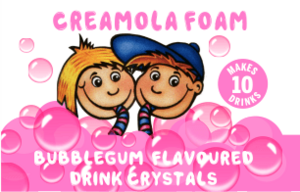Creamola Foam facts for kids
 |
|
| Type | Soft drink |
|---|---|
| Country of origin | Scotland |
| Introduced | 1950 |
Creamola Foam was a super fun soft drink that came as fizzy crystals. You just mixed these crystals with water to make a bubbly drink! It was made in Glasgow, Scotland, and sold across the UK starting in the 1950s.
Sadly, a company called Nestlé stopped making it in October 1998. But guess what? In 2005, a person named Allan McCandlish started making a similar drink called 'Kramola Fizz'.
Then, in April 2019, Allan's children, Agnes and Andrew, brought Creamola Foam back! They relaunched it under its original name. Now, you can find it in stores in Scotland and even around the world.
Contents
What is Creamola Foam?
Creamola Foam came as colorful crystals. When you mixed them with cold water, they dissolved into a sweet, fizzy drink. The original packaging was a small tin. It had a cartoon picture of a boy and girl drinking with straws.
Flavors and Companies
At first, Creamola Foam came in raspberry, orange, and lemon flavors. Later, a cola flavor was added too.
The product was first owned by Rowntrees. Then, it was taken over by Nestle UK. After that, it was sold to another company called Premier Foods.
The Creamola Foam that was relaunched in 2019 comes in many flavors. There are 17 different ones! These include the original flavors like Raspberry, Orange, Lemon, and Cola.
How It Was Packaged
The first Creamola Foam came in a small tin. It had a tight metal lid that you usually had to pry open with a spoon. Inside, a paper seal covered the fizzy crystals.
The tin had some cool phrases printed on it:
- "CREAMOLA FOAM CRYSTALS"
- "MAKES 10 BIG DRINKS"
- "FULLY SWEETENED"
What Was Inside?
The original ingredients were:
- Sugar
- Fruit acids (for a sharp taste)
- Sodium bicarbonate (this helps make it fizzy!)
- Gum acacia, which made it a bit thicker
- Saccharin, a sweetener
- Saponin, which made the foam bubbles
- Flavoring
- Color
Later Changes
In the 1980s, Creamola Foam got a new look. It had a plastic lid and a more modern design. The label simply said, "Creamola FOAM".
New Ingredients
The ingredients changed a bit in the 1980s:
- Sugar
- Citric acid
- Sodium bicarbonate
- Tartaric acid
- Flavoring
- Saccharin, a sweetener
- Gum acacia, a thickener
- Extract of quillaia, which helped make the foam
- Carmine, a food coloring (used in the raspberry flavor)
Why It Fizzes
The fizzing happens when the powder mixes with water. The citric and tartaric acids react with the sodium bicarbonate. This reaction creates carbon dioxide gas, which makes all those bubbles! These "fruit" acids also give the drink a tangy taste.
The special thickeners and foaming agents help the bubbles last longer. Even though it had fruit acids, the drink's flavor and color mostly came from artificial ingredients.
See also
- Fizzies, a similar fizzy drink from the US.

